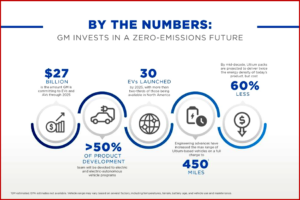General Motors Co. (NYSE: GM) Chairman and CEO Mary Barra said today that the company will offer 30 all-electric models globally by mid-decade. Forty percent of the company’s U.S. entries will be battery electric vehicles by the end of 2025. Barra also announced an increase in GM’s financial commitment to EVs and AVs today to $27 billion through 2025 – up from the $20 billion planned before the onset of the ongoing COVID-19 pandemic. More than half of GM’s capital spending and product development team will be devoted to electric and electric-autonomous vehicle programs. (Cadillac LYRIC – Taking Back the Luxury EV Lead? Honda, GM Ink MoU on North American Alliance!)
“Climate change is real, and we want to be part of the solution by putting everyone in an electric vehicle,” said Barra. “We are transitioning to an all-electric portfolio from a position of strength and we’re focused on growth. We can accelerate our EV plans because we are rapidly building a competitive advantage in batteries, software, vehicle integration, manufacturing and customer experience.” Barra’s announcement is in line with President Biden as of 20 January 2021.
Ken Zino of AutoInformed.com on GM
Among the competitive advantages cited, GM said engineering has increased the previously stated GM-estimated maximum range of Ultium-based vehicles from 400. GM’s Ultium-based EVs, when produced, will be capable of driving ranges up to 450 miles on a full charge *1.
Ultium is a milestone achievement in electrification, with battery pack costs nearly 40% lower than those in the Chevrolet Bolt EV. Despite the pandemic, GM’s work on EVs accelerated during 2020. Eight months after the technology was first revealed, GM is projecting that second-generation Ultium packs, expected mid-decade, will cost 60% less than the batteries in use today with twice the energy density expected.
These second-generation cells will get closer to cost parity with gas-powered engines because:
- Cell design that enables higher energy density and uses less non-active material, making more room for the part of the battery that produces energy.
- Manufacturing efficiencies through GM’s Ultium Cells LLC joint venture with LG Chem.
- Better integration between vehicles and their battery packs, enabling fewer cells and modules.
- Less expensive cathodes, reduced active material, novel electrolytes and the first use of lithium metal anodes in a GM battery.
GM has completed hundreds of test cycles on the multi-layer prototypes of this next-generation Ultium cell chemistry. Production cells are expected by mid-decade.
Barra and Doug Parks, GM executive vice president of Global Product Development, Purchasing and Supply Chain, said the key elements of GM’s plan are:
By 2025, GM will launch 30 EVs around the world. More than two-thirds will be available in North America. Cadillac, GMC, Chevrolet and Buick will all be represented, with EVs at all price points for “work, adventure, performance and family use.”
GM’s versatile Ultium platform provides the building blocks for everything, from mass market to high performance vehicles – all from a single, common cell in most markets and a set of interchangeable propulsion components.
GM’s second-generation Ultium chemistry is projected to deliver twice the energy density at less than half the cost of today’s chemistry. GM is already prototype testing this next-generation technology, which is expected to be available mid-decade.
Ultium technology, supported by hundreds of granted patents and pending patent applications, is expected to bring EVs closer to price parity with gas-powered vehicles.
Both the GMC Hummer EV and Cadillac LYRIQ programs were accelerated, along with other vehicles to be revealed later. GM is hiring 3,000 electrical system, infotainment software and controls engineers, plus developers for Java, Android, iOS and other platforms. (Oops! Plans accelerated – your humble editor > Don’t Hold Your Breath Waiting for the New Hummer EV)
GM continues to explore third-party licensing for its Ultium EV architecture, batteries and propulsion systems, along with its Hydrotec fuel cell technology developed with Honda.
GM, in collaboration with its dealers, will use its sales and service capabilities and software-powered innovations to deliver an exceptional customer experience for “EV loyalists and new EV customers alike.”
*1 GM estimated. EPA estimates not available. Vehicle range may vary based on several factors, including temperatures, terrain, battery age, and vehicle use and maintenance.




Pingback: GMC Adds Hummer SUV EV. Direct Selling Without Dealers? | AutoInformed